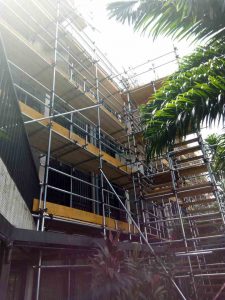Basic Scaffold Erection Training (Level 1 ---- New Scaffolders)
 Types of Scaffold
Types of Scaffold
Mobile tower Tubes & Fittings System (Ringlocks or Cuplocks)
Training Outline & Joining Instruction
Training starts by 9AM and close by 4PM
Lunch Break: 12-1PM Daily
Tea Break: As considered appropriate by the team.
Course Duration 10 days.
COURSE SYLLABUS
Day 1:
Introduction to Scaffold Types
Common accidents with scaffolding
Risks and Hazards when building / assembling scaffolds
Basic Theory of Scaffolds
Regulatory requirements
Basic Theory, types, component names and Layout of Tube and Clamp Scaffolds
Tie in / Height to width & stability aspects in scaffolding
Scaffold loading basics and implications on design / best practices on ways to prevent overloading
Inspection and quality assessments of Tubes, Boards, Couplers and scaffold components pre use
Gates, Ladders and stairs – best practices in scaffolding
Work at Height protection when building scaffolds.
Medical Aspects when selecting Scaffolding personnel
Scaffold pre use and weekly assessment.
Practical Training in Scaffolding systems – Tower scaffold, Tube and Pipe – layout, alignments, footings, boarding out, diagonal bracing and tie in solutions.
Practical Training in Scaffold assessments.
Assessment – theoretical and practical in scaffolding and pre use assessments.
Health & safety awareness
Instruction/training SG4:10
Ladder access to scaffolds
Performance Standards (BS EN 12810/11 and TG20:13
Manual handling
Products in approved prefabricated system scaffolds
Interpretation of drawings
Tie methods & TG4
Erect/dismantle of independent access scaffold
Erect/dismantle of birdcage scaffolds
Erect/dismantle of tower scaffolds
Erect/dismantle of putlog scaffolds
TG20 Stair Access (theory & practical)
Alterations to scaffolds
Theory & practical application of gin wheels
50 question test paper
Review of course
NOTE:
- All Trainees are required to come with Safety Coverall, Hard Hat, Safety Boot, Safety glasses and hand gloves.
- Anyone under medication can not be admitted for practical session, hence must declare prior to the session
Equipment
Delegates must wear PPE (Personal Protective Equipment) during the practical aspects of the course. Delegates will be required to provide:
Hard Hat
Safety Boots
High visibility vest or overalls (optional)
Safety Harness with 1.7m lanyard and rear anchor point
Tools:
- 1x 7/16 swingover spanner
- 1x belt and frogs
- 1x 6” spirit level
Scaffold Erection (Basic to Advanced level)
Independent
Independent with return
Mobile tower
Static tower
Putlog
Birdcage
System
Training Outline & Joining Instruction
Training starts by 9AM and close by 4PM
Lunch Break: 12-1PM Daily
Tea Break: As considered appropriate by the team.
COURSE SYLLABUS
Day 1:
Introduction to Scaffold Types
Common accidents with scaffolding
Risks and Hazards when building / assembling scaffolds
Basic Theory of Scaffolds
Regulatory requirements
Basic Theory, types, component names and Layout of Tube and Clamp Scaffolds
Tie in / Height to width & stability aspects in scaffolding
Scaffold loading basics and implications on design / best practices on ways to prevent overloading
Inspection and quality assessments of Tubes, Boards, Couplers and scaffold components pre use
Gates, Ladders and stairs – best practices in scaffolding
Work at Height protection when building scaffolds.
Medical Aspects when selecting Scaffolding personnel
Scaffold pre use and weekly assessment.
Day 2-6
Practical Training in Scaffolding systems – Tower scaffold, Tube and Pipe – layout, alignments, footings, boarding out, diagonal bracing and tie in solutions.
Practical Training in Scaffold assessments.
Assessment – theoretical and practical in scaffolding and pre use assessments.
Health & safety awareness
Instruction/training SG4:10
Ladder access to scaffolds
Manual handling
Products in approved prefabricated system scaffolds
Interpretation of drawings
Tie methods & TG4
Erect/dismantle of independent access scaffold
Erect/dismantle of birdcage scaffolds
Erect/dismantle of tower scaffolds
Erect/dismantle of putlog scaffolds
Alterations to scaffolds
Theory & practical application of gin wheels
50 question test paper
Review of course
NOTE:
All Trainees are required to come with Safety Coverall, Hard Hat, Safety Boot, Safety glasses and hand gloves.
Anyone under medication can not be admitted for practical session, hence must declare prior to the session Equipment Delegates must wear PPE (Personal Protective Equipment) during the practical aspects of the course. Delegates will be required to provide:
Hard Hat
Safety Boots
High visibility vest or overalls (optional)
Safety Harness with 1.7m lanyard and rear anchor point
Tools: o 1x 7/16 swingover spanner o 1x belt and frogs o 1x 6” spirit level o 1x 5m Tape measure
TRAINING ON WORKING AT HEIGHT
Training Module
- Introduction to Work at Height
- Basic Theory of WAH and Controls, Anchor design criteria and testing
- Calculation of fall distances and role of shock absorbing lanyards
- Work at Height permitting and roles.
- Basic Theory on WAH Post Fall Recovery Plans, Options and Hardware
- Medical Aspects when selecting WAH personnel
- Practical Training in WAH fall protection systems – Fall Restraints systems, fall restriction systems & Fall arrest systems, Anchor point Selections, walking and movement using double lanyards over scaffold and ladders – typically a scaffold or structures should be used to practice and observe double lanyard movement, experience of a harness and trauma prevention devices.
- Practical Training in WAH Rescue Basics
- Theoretical and Practical use of fixed CAT ladders and access ladders
- Theory and Practice in Use of Elevated Platforms (Lafarge Nigeria will provide platform and operator)
- Assessment – theoretical and practical in WAH and permitting / using WAH systems.
We would like to propose the below;
- A scaffold will be erected for practical purposes
- An elevated platform/scissors lift/cherry picker will be used for practical purposes
- Training shall meet the requirement of OSHA : 29 CFR 1910; and 1926.502 and UK Work at Height Regulations 2005
DELIVERABLES
- CD containing course materials, videos, regulations etc
- Handout copies of OSHA Scaffold Manual
- Trade Test Certificates ( if needed)
